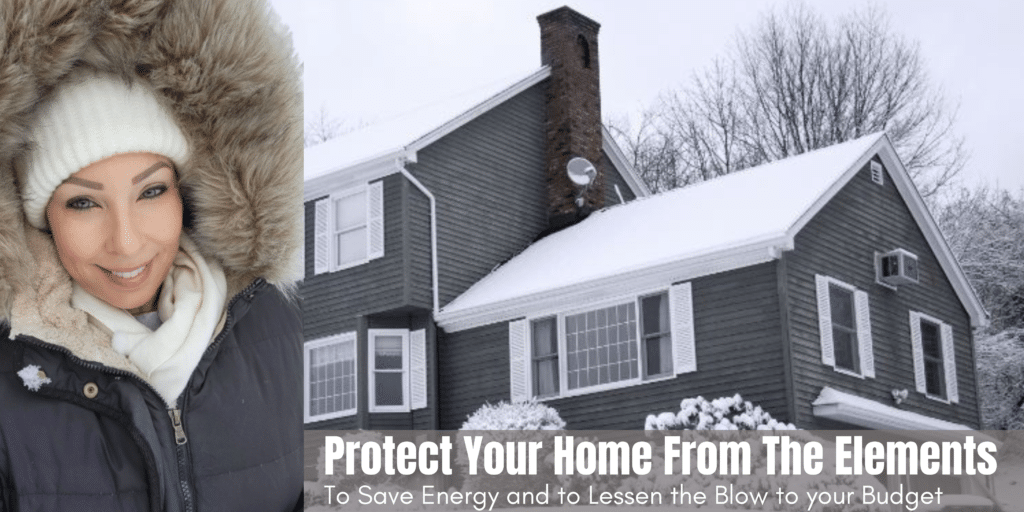
Protecting your home from the elements has always been important, but with escalating energy costs, it’s more important now that it’s ever been.
With this said, I’m sure I’m not the only one who saw an extremely sharp increase in my home heating bill after January 1st. In fact, it went up from $220 in December of 2021 to $315 in December 2022 for almost the exact same consumption. That’s an increase of 50%.
The following month, our consumption actually dropped quite a bit over the same time last year and our bill was another $30 higher than the previous month.
Crazy right!?!
If you compare your bills, there are not only increases in fees, but also a new fee or two which is having a big impact on our wallets.
The utility company states on the bill that you should keep your home at 16.67 celsius or 62 farenheit at night and 20 celsius / 68 farenheit during the day. I don’t know about you, but that is COLD – especially at night. We’d been keeping our home around 20 celsius at night and 22 during the day. I tried to drop it by a couple of degrees but we had to raise it back up. We were FREEZING!!
So, if dropping the temperature on the thermostat, at least by this much, isn’t an option, then today I wanted to share a blog post about all the ways you can protect from elements and secure your home so money isn’t leaking out the door.
If that doesn’t encourage you to start protecting your home from the elements, then I don’t know what will!
Here are some tips to help you keep your home warm in the winter and cool in the summer:
Protecting your home from the elements starts off by insulating efficiently. This is one of the most effective ways to conserve energy and protect your home from the elements. Make sure that your walls, roof, and floor are properly insulated to prevent heat from escaping.
Of course, heat rises so ensuring your attic is appropriately insulated is extremely important. Using unfaced insulation in your attic will help prevent the heat from rising and only heating the attic instead of your living spaces. And don’t let the term insulation intimidate you, even the most inexperienced individual can handle this job.
Simply buy rolls of unfaced insulation and unroll it on the floor of your attic. Make sure the spaces between the joists are full of insulation, and when that is complete, you can go a step further and apply a second layer that runs perpendicular to the joists.
This can make a significant impact on your energy bills and is probably one of the most efficient energy saving options. And remember, anyone can do it!
Okay, so this project is a little more advanced but effective nonetheless. If you have an uninsulated wall in your home, such as a solid brick or concrete wall, installing drywall over the top can save a ton of energy.
By adding thick drywall, and some glass wool (which is also an excellent insulator), your cold wall will now be warm and help to keep the cold air out. Protecting your home from the elements is actually far more simple than most people realize when you think about it like this.
In addition to all of these things, you also want to insulate your water heater. This is kind of like adding a jacket to it so you can keep your water warmer during the colder months without using extra energy to heat it up.
All you have to do is buy a fiberglass jacket from a home improvement store and wrap it around your water heater like a blanket.
Adding this extra layer of insulation will reduce heat loss drastically, and you will recoup the money you spend in just a few months with all the money you will be saving!
Further to the point above, seal your windows and doors. Air leaks around windows and doors can cause significant heat loss in the winter and unwanted heat gain in the summer. Use weather stripping and caulking to seal any gaps and prevent drafts. Combatting drafts is a huge component in protecting your home from the elements.
To seal drafty doorways, use rubber weatherstripping to fill spaces between the sides and bottom of your door and the door frame. If the space between the bottom of the door and your floor is extra large, you can use a double draft stopper.
This is primarily two cylindrical pieces of foam that slide on to the front and back of your door to prevent drafts from seeping in under the door itself. It is very effective at preventing cold air from coming into your home in the winter, and can easily be slid on and off for convenience.
For your drafty windows, although not pretty, with some plastic sheeting and a hairdryer, you can add an entire layer of protection to windows in your home.
Buy plastic sheeting with double-sided tape at almost any store, simply stick the sheeting to the walls and window sill and tighten the plastic by blowing hot air on the sheeting with a hairdryer.
This is an easy, inexpensive, and practical way of sealing off windows for the winter months.
In addition, curtains are pretty, light, flowy, and perfect for summer, but winter requires something a little different. If your home has drafty windows, it would be smart to invest in some long, thick, and heavy curtains. I bet this wasn’t something on your list when you decided to work on protecting your home from the elements, was it?
Hanging these thicker curtains will help dramatically when it comes to keeping the cold out and the heat in. If your windows are particularly drafty, purchase curtains that have a thermal back for an extra layer of protection against the cold breeze.
Next up, make sure you have energy efficient windows. If your windows are old and drafty, consider replacing them with energy-efficient windows that have multiple panes and low-emissivity coatings.
Is your thermostat programmable? If not, this is a worthwhile investment. A programmable thermostat can help you control the temperature in your home more efficiently. Set it to automatically adjust the temperature based on your schedule and habits.
Another great option to protect your home from the elements is by using shading devices. If you’re not familiar with these, they are ultimately blinds, curtains, shades and any other window covering to block sunlight and reduce heat gain in the warmer months. In the winter, keep these open to let the sun shine in!
In addition to shading, you can plant trees or install shading screens. More specifically, planting trees or installing shading screens on the south and west sides of your home can help reduce the amount of direct sunlight that enters your home and reduce your cooling costs.
You can also consider installing a roof ventilation system. Proper roof ventilation can help reduce heat buildup in your attic and lower your cooling costs.
A fairly simple solution to help is to use a dehumidifier. Excess moisture in your home can make it feel warmer in the summer and colder in the winter. Using a dehumidifier to remove excess moisture will maintain a comfortable indoor environment.
If you feel like your home isn’t properly protected from the elements, the best next step would be to hire a professional energy auditor. A professional energy auditor can identify areas in your home where energy is being wasted and recommend ways to improve your home’s energy efficiency.
By following these tips, you can protect your home from the elements and conserve energy, ultimately resulting in lower monthly utility bills and a more comfortable living environment.
I hope you’ve found these tips on protecting your home from the elements to be helpful in combatting escalating utility charges and reduce energy loss.
As the spring season approaches, if finding a new home to love has been on your mind, let’s talk! I can be reached at 647-896-6584, by email at info@serenaholmesrealtor.com or by filling out this simple contact form.
For plenty of other great tips for home owners, make sure we’re connected on social and you’ve subscribed to my youtube page.










